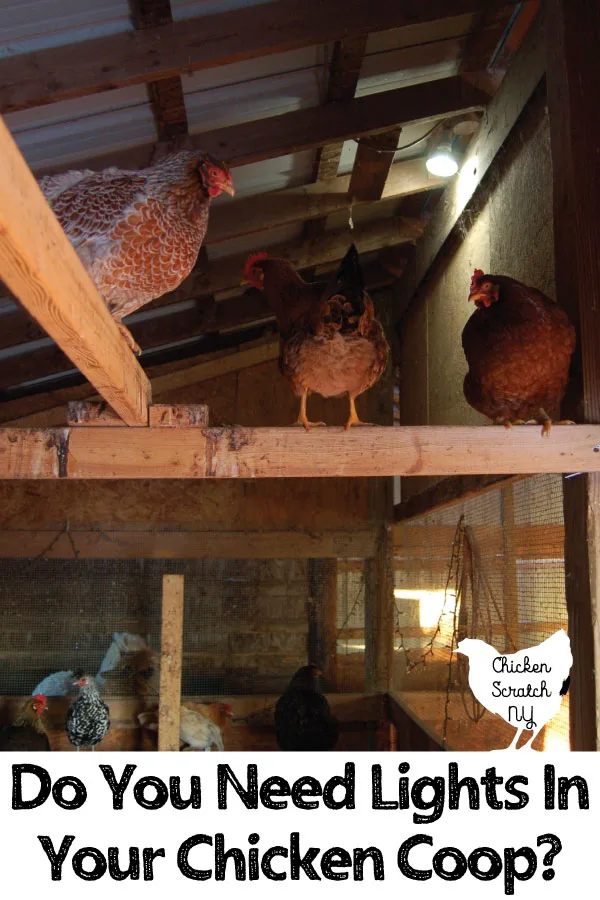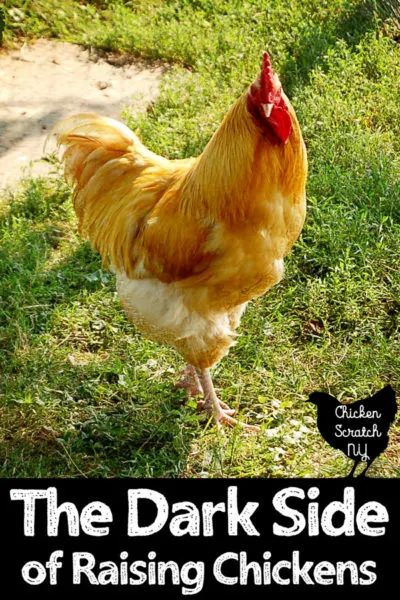Taking care of chickens in the winter isn’t necessarily difficult but it is different and you need to be ready for the cold temps and snowfall. Maybe even in ways you haven’t anticipated.
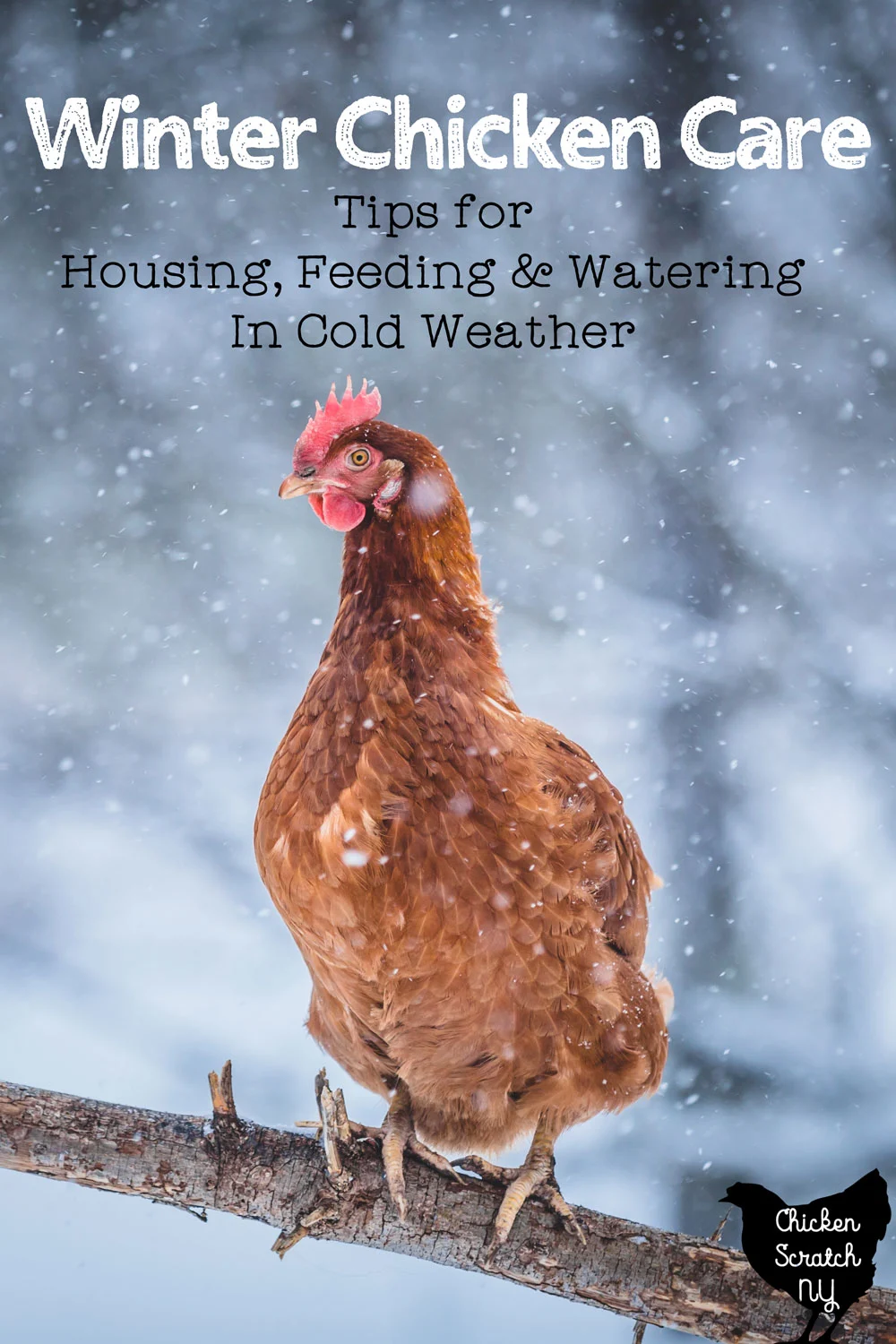
Winter is here, the snow is falling and you’re all cozy with hot cocoa and a warm blanket but what about your chickens? You can’t exactly bring them inside to cuddle fireside!
The main things chickens need, food, water and housing don’t change. But the way you provide those things will.
There is a lot of advice floating around about how to take care of chickens in the winter and honestly, a lot of it seems impractical and regurgitated. I’m going to do my best to communicate what I actually do and how I deal with having chickens in a winter wasteland.
If you aren’t familiar with me and Chicken Scratch NY, I live in Central NY in a snowy, snowy area where we get hit with lake effect (that means 12+ inches in hours) storms several times a year. It also gets really cold with the wind chill, like -30 degrees.

I have a large coop sectioned off in a larger barn, it’s 2/3 of my roughly 20 x 30 barn. The chickens share the space with my two alpacas, Fred & Oki, and my 9 geese, 5 ducks, 17 (yes 17) guineas and 5 turkeys.
Feeding Chickens in the Winter
This is one of those areas where I see the same thing thrown out again and again “never feed your flock in the barn”. Which in theory I understand, food in the barn brings in mice and rats.
BUT there are times when I can’t even open the doors or there’ll be literal snowbanks in the barn or can only crack open the door to let the alpacas our to frolic. Those days are usually sandwiched between days with feet of snow on the ground.
I don’t know about your chickens but mine are spoiled little princesses and will not step foot in anything more than a light dusting of snow.
If I want my chickens to eat I need to feed them in the barn/coop and if you live somewhere with winter you probably will too.
Moving on to the actual feeding part:
The bad news here is that chickens eat a lot more in the winter, at least you’ll need to feed them a lot more! And of course, this is the time of year then they’re laying the fewest eggs.

I’m a huge fan of free-ranging my birds, I feed them in the morning and send them out into the world to find their own food. Partially because it keeps them busy, they get a varied diet and also because it saves money.
Chickens are stubborn but even they can’t find the worms under 12 inches of snow with frozen soil. Which means that I end up feeding about double what I do in the spring, summer and fall.
The other reason chickens need to eat more in the winter is because it’s cold. One way they keep their body heat up is by digesting food.
Your birds should have molted going into winter, growing in a new coat of feathers to hold that body heat in, but it’s got to come from somewhere.
Read more about The Fall Molt & Your Flock
Most of the year I throw out a bucket of corn in the morning and then call it a day, in the winter I take another bucket out in the late afternoon and bring in extra treats. Speaking of:
Chicken Snacks and Treats:
This is another one of those topics where I go against the grain. I don’t actually feed my flock laying ration on a regular basis. I feed them whole corn that I buy from a local farmer, whole oats, whole wheat, and all the scraps from my kitchen.
When I pick up the alpaca food at the store I might grab a bag of grower or flock raiser for a treat but I prefer to provide a calcium supplement and leave it at that.
My oldest chicken is 9 and a half years old and none of my birds are unhealthy, under or overweight. I think a large part of that is the free-ranging, if you don’t have that option with your birds I would avoid the single source diet.
Here are a few options for chicken snacks and treats:

- Whole Cabbages
- DIY Flock Blocks
- Whole Apples
- Cooked Eggs
- Greens like kale, swiss chard (geese really like this!)
- Oatmeal
- Kitchen Scraps like carrot peels, apple cores, toast etc.
Avoid salty foods, chocolate, raw onions and citrus - Bird Seed
- High-quality dog food for a protein boost
One of our molting-time treats is a dozen eggs (shells and all) scrambled with bird seed, dog food and grower or layer baked in 9 x 13 pan until set, cooled and cut into chunks.
I do something similar when I clean out the pantry and find a box of buggy pasta or rice. It gets cooked up and fed to the chickens. We waste very little food around here!
Keeping Food Safe
Going back to that initial advice against ever feeding your chickens in the coop, one of the biggest struggles when keeping your chickens fed in the winter is dealing with mice, rats, and possibly even raccoons and skunks.
I never keep food in the barn, instead, I store it in large lidded metal trash cans in my garage. Metal keeps the mice out and I can back my car right in and unload the food without having to lug 300# of corn very far.
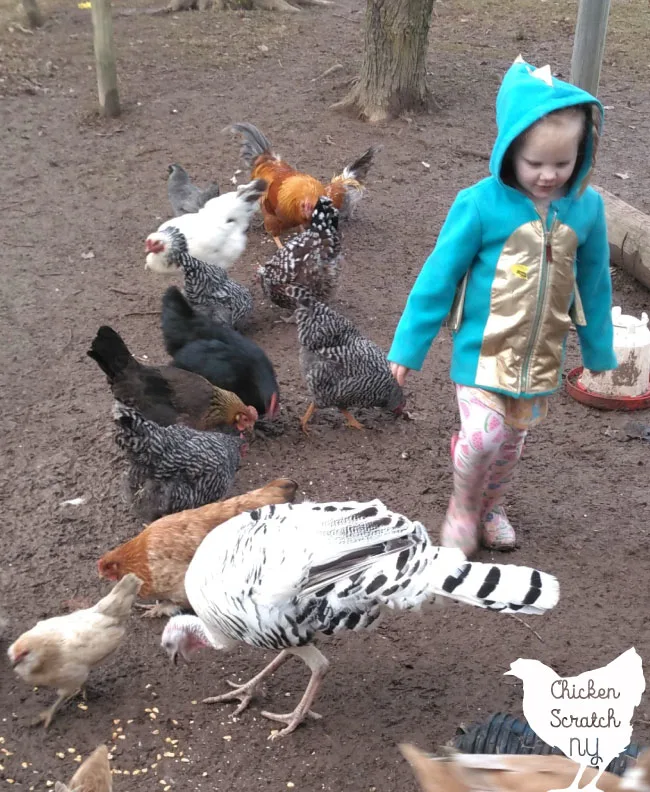
When the ground isn’t covered with snow I try to avoid feeding in the barn at all, it’s only the alpacas and the pens with moms and babies that get room service.
Read more about Broody Hens and Chickens Raising Chicks
I will toss the occasional scoop in the coop to inspire my chickens to dig and scratch up the bedding in my dirt-floor deep-liter method coop but that’s another post entirely!
Unfortunately, that doesn’t really work in the winter and everything gets scattered in the coop and barn. Instead, I try to feed early enough that all the food is gone by night time when the mice get brave enough to come out (by the way, chickens eat mice).
I don’t even bother with feeders, I have too many birds and it’s easier to just throw the food out on the ground. There are a few benefits to this.
It lets everyone get to eat, not just the geese and guineas. It also gives the chickens something to do while they scratch and peck and since I have a dirt floor and use the deep liter method it keeps things turned over.
Feeding on the ground is not recommended if you’re dealing with coccidiosis. I’ve only have one round of that disaster and it’s most commonly an issue in younger birds which you hopefully won’t have too many of by winter.
Watering Chickens in the Winter
Moving on from food, getting water to your chickens in the winter is the real struggle. On really cold days the water seems to freeze almost as fast as you can bring it out.

This image is from the springtime, you definitely don’t want you chickens standing in water like this in the winter!
On top of basic survival, chickens need water to digest their food and to lay eggs. So it’s not something you can overlook.
You pretty much have two options, you can bring out water more often or find a way to keep the water from freezing. I have tried a lot of things and at this point, I’ve resigned myself to bringing out gallons of water a few times a day.
My biggest challenge isn’t the chickens, along with them I also have to keep my ducks and geese happy. They need to be able to dunk their nostrils in water to keep them clean.
I take 3 gallon jugs filled with water from the house 2-3 times a day depending on how cold it is and how quickly the water freezes. The water gets dumped into black rubber bowls and into a bucket for the alpacas.
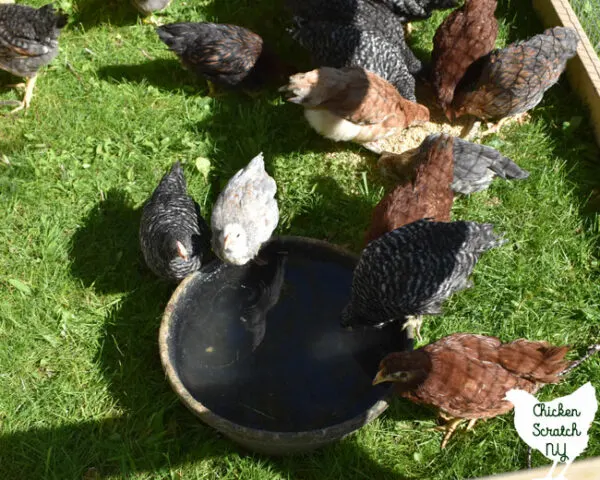
The rubber bowls are great because when they inevitably freeze you can take them outside, flip them over and jump up and down on them to dislodge the ice. They also don’t crack like plastic buckets.
There are lots of tricks and hacks out there for keeping water from freezing but the only guaranteed way is to heat the water above freezing.
You can do this with a metal base heater that needs to be used with a metal waterer or you can use a plastic waterer with a built-in heater. I have used both but I don’t use either any longer.
Electricity and water are not a great combo and I see it as an unnecessary risk. One of my heated waterers malfunctioned and the plastic melted in a way that could have easily caused a fire and burned my entire barn down.
Where to Water?
This goes back to one of those “never ever do this” things that always gets tossed around. I would love to never have water in my barn but it’s just not possible.
Once you’ve settled on a way to get the water to your chickens you need to designate a good spot for it. I’m lucky enough to have a large barn and I keep the water bowls secluded in a corner.
Thanks to the ducks, geese and my own clumsy refilling the water area quickly turns into an ice rink. When things get extra slippery I toss down extra wood shavings to add some traction.
You can keep the water outside if you have a sheltered area, I wish I had a good place for this! Just make sure your birds are going out to get the water, some chickens won’t walk through snow.
Should I Give Chickens Warm Water?
First off, don’t ever give your chickens hot water. The idea behind giving them warm water is that it will take longer for the water to freeze and that warm water is nicer to drink on a cold day.
I aim for lukewarm water for my chickens. All of my water comes from a well and my cold water is cold.
At the same time, I don’t want to bring really warm water out because it gets really steamy and humidity isn’t something you want in your barn or coop.
Housing Chickens in the Winter
In a way, housing chickens in the winter might be the biggest challenge you face. Your biggest battle will come down to space.
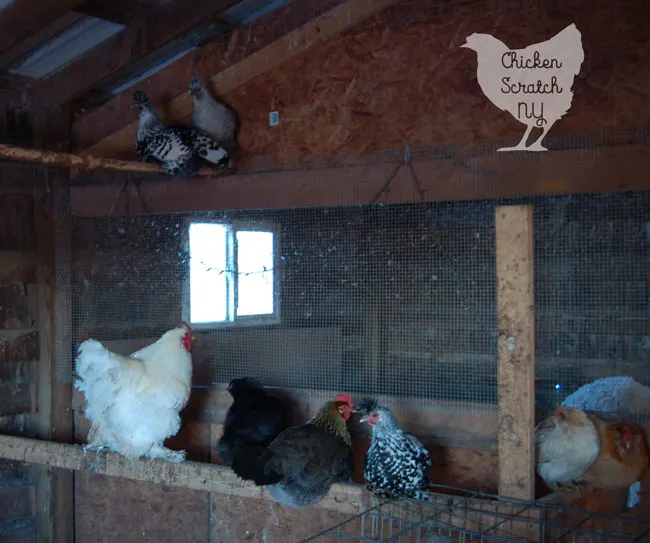
The same coop that seems large and spacious in the spring when your chicks are still small, decent in the summer and fall when they only come in to roost can be dare I say, snug when the snow piles up and the stubborn birds refuse to go outside!
Flocks that get along great when everyone spreads out can start fighting and certain birds (usually roosters low in the pecking order) can even get kicked out to face the elements.
While it may be too late to expand your coop now, keep your winter space in mind when you plan any future flock growth.
If you find your birds are too cramped in the coop you can add space by building a covered run or just shovel or snow blow an area and throw down straw so they have a snow-free space to enjoy.
Heating Chicken Coops
My advice for heating a chicken coop is do not heat a chicken coop. It’s unnecessary and dangerous.
Chickens are very sturdy birds, they actually handle the cold much better than they deal with heat. Healthy chickens with a good diet and a full coat of feathers are perfectly capable of surviving frigid temperatures.

Chickens keep warm in cold weather by puffing up their feathers to hold in their body heat. You may notice them pick up one foot at a time and snuggling it into that warm bubble when they’re out and about in the winter.
Learn more about 3 Hardy Heritage Breeds Bred for Cold Weather
The best way you can help your chickens adjust to cold weather is by letting them adjust to cold weather over time.
If you add heat to the coop you don’t let them do that, instead when you get that big snowstorm and your power goes out your chickens are suddenly living in a frigid hellscape with no preparation.
Instead of worrying about heat, you need to make sure your coop is draft-free and dry. Moisture in the coop can lead to frostbite on combs, wattles and feet.
Your coop should never be damp and you should never notice ammonia smells. If you notice either of those things happening get in there and either clean it out or if you use the deep litter method add in extra bedding like straw or wood shavings and mix everything up.
Read about Feather Footed Chickens & Keeping Mud Off Eggs
I use wood shavings most of the year but I like to add a thick layer of straw in the winter to give the ducks and geese something to snuggle into.
Winter Roosts
Nighttime is usually when the temps get even colder and the birds are roosting in one position.
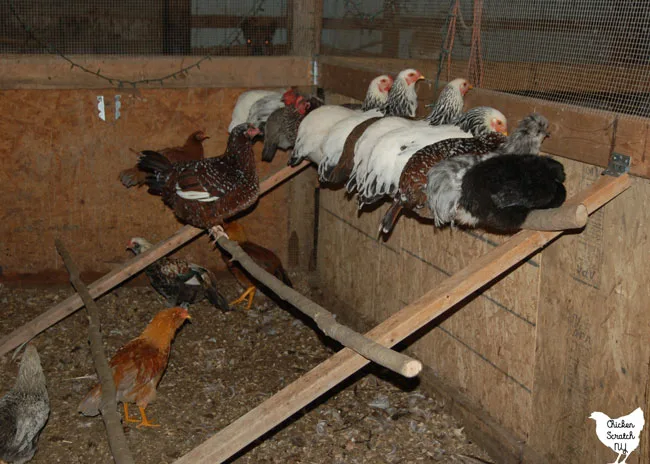
I’ve seen it in a few places to flip any 2×4 roosts so the flat side is up, that way the chickens can keep their feet on a flat surface and cover them fully with their feathers.
In my coop I’ve been switching my roosts from 2x4s to thick tree branches, the varying diameters give the different sized birds a shot to find a good spot for their feet.
Learn How to Make a Fold Up Roost
My chickens also seem to sleep where ever they want, they certainly aren’t limiting themselves to the roosts.
Eggs in the Winter
The sad truth is that eggs slow down in the winter. It has a lot to do with day light and you can get more eggs by supplementing with artificial light in the coop.
Read more about Adding Light in the Chicken Coop
Whether you decide to add light or not (I do, for several reasons that don’t even involve eggs, check out that link above for more information on that) you’ll still be getting fewer eggs in the winter.
Some breeds of chickens, particularly the heavier breeds like Brahmas, seem to lay through cold weather without any issues. If winter eggs are something you are interested in you might want to look into those hartier dual purpose breeds.
The other big, big problem you can get with eggs in the winter is that they freeze. Eggs are largely liquid and when that liquid freezes it expands and the shells break.
I usually cook the frozen eggs and feed them to my dog, cats or back to the chickens themselves. Once the shells break the eggs are opened up to contamination and I’m just not interested in eating something that was rolling around in a nest box.
Side note, if you place a frozen egg in your pocket and then throw the coat on the coat rack and forget it, you’ll have a gross eggy jacket on your hands. Don’t do that.
Read more about What to Expect from Farm Fresh Eggs
The only way to prevent frozen eggs is to collect them quickly, instead of grabbing eggs once a day you might have to collect 2 or 3 times a day.
I like to fill my nest boxes up with straw but a thick layer of wood shavings will have a similar insulative effect that keeps your eggs from freezing as quickly.
The Rest
I think this covers the critical issues about food, water, and housing. Which is great because this post is already a monster.
Of course, I still have more say about the struggles and joy of caring for chickens in the winter months. Fortunately, I’ve got most of it covered already in other posts:
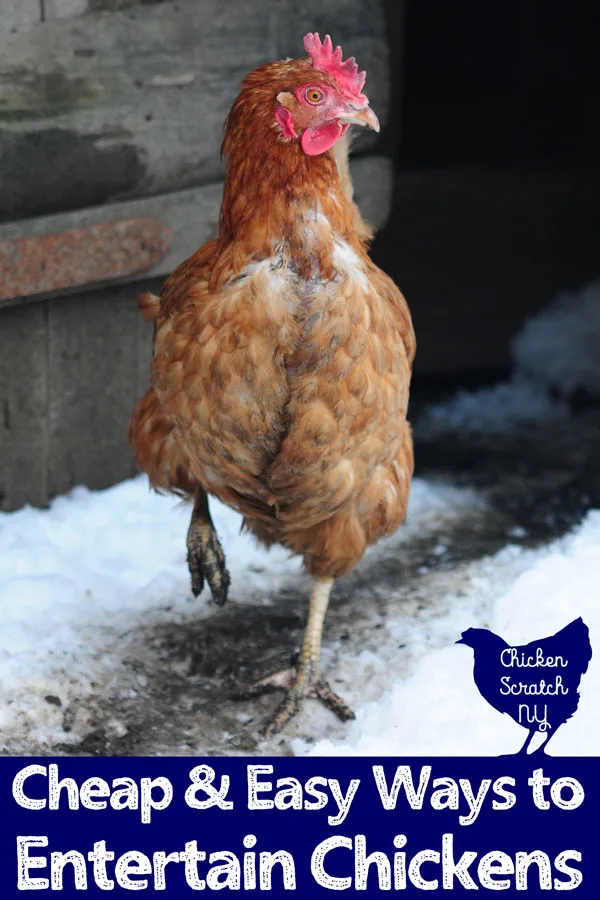
Don’t forget to PIN this to your chicken board!
Read more about Raising Chickens


